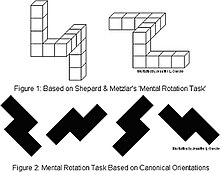Differences in human intelligence have long been a topic of debate among researchers and scholars. With the advent of the concept of g or general intelligence, many researchers have argued for no significant sex differences in g factor or general intelligence, while others have argued for greater intelligence for males, and others for females. These results depend on the methodology, tests researchers used for their claims, and the personal performances of the participants.
Some research indicates male advantages on some cognitive tests are minimized when controlling for socioeconomic factors. Other research has concluded that there is larger variability in male scores compared to female scores, which results in more males than females in the top and bottom of the IQ distribution.
Additionally, there are differences in the capacity of males and
females in performing certain tasks, such as rotation of objects in
space, often categorized as spatial ability.
Historical perspectives
Prior to the 20th century, it was a commonly held view that men were intellectually superior to women. In 1801, Thomas Gisborne
said that women were naturally suited to domestic work and not spheres
suited to men such as politics, science, or business. He stated that
this was because women did not possess the same level of rational
thinking that men did and had naturally superior abilities in skills
related to family support.
In 1875, Herbert Spencer
said that women were incapable of abstract thought and could not
understand issues of justice and had only the ability to understand
issues of care. In 1925, Sigmund Freud
also stated that women were less morally developed in the concept of
justice and, unlike men, were more influenced by feeling than rational
thought. Early brain studies comparing mass and volumes between the sexes concluded that women were intellectually inferior because they have smaller and lighter brains.
Many believed that the size difference caused women to be excitable,
emotional, sensitive, and therefore not suited for political
participation.
In the nineteenth century, whether men and women had equal intelligence was seen by many as a prerequisite for the granting of suffrage. Leta Hollingworth argued that women were not permitted to realize their full potential, as they were confined to the roles of child-rearing and housekeeping.
During the early twentieth century, the scientific consensus shifted to the view that gender plays no role in intelligence, but men consistently overestimated their IQs and women consistently underestimated their IQs.
In his 1916 study of children's IQs, psychologist Lewis Terman
concluded that "the intelligence of girls, at least up to 14 years,
does not differ materially from that of boys". He did, however, find
"rather marked" differences on a minority of tests. For example, he
found boys were "decidedly better" in arithmetical reasoning, while
girls were "superior" at answering comprehension questions. He also
proposed that discrimination, lack of opportunity, women's
responsibilities in motherhood, or emotional factors may have accounted
for the fact that few women had careers in intellectual fields.
Research on general intelligence
Background
Chamorro-Premuzic
et al. stated, "The g factor, which is often used synonymously with
general intelligence, is a latent variable which emerges in a factor
analysis of various cognitive ('IQ') tests. They are not exactly the
same thing. g is an indicator or measure of general intelligence; it's not general intelligence itself."
All or most of the major tests commonly used to measure
intelligence have been constructed so that there are no overall score
differences between males and females. Thus, there is little difference
between the average IQ scores of men and women. Differences have been reported, however, in specific areas such as mathematics and verbal measures.
Also, studies have found the variability of male scores is greater than
that of female scores, resulting in more males than females in the top
and bottom of the IQ distribution.
In favor of males or females in g factor
Research, using the Wechsler Adult Intelligence Scale (WAIS III and WAIS-R), that finds general intelligence in favor of males indicates a very small difference. This is consistent across countries.
In the United States and Canada, the IQ points range from two to three
points in favor of males, while the points rise to four points in favor
of males in China and Japan. By contast, some research finds greater advantage for adult females. For children in the United States and the Netherlands, there are one to two IQ point differences in favor of boys. Other research has found a slight advatage for girls on the residual verbal factor.
A 2004 meta-analysis by Richard Lynn and Paul Irwing published in 2005 found that the mean IQ of men exceeded that of women by up to 5 points on the Raven's Progressive Matrices test. Lynn's findings were debated in a series of articles for Nature.
He argued that there is a greater male advantage than most tests
indicate, stating that because girls mature faster than boys, and that
cognitive competence increases with physiological age, rather than with
calender age, the male-female difference is small or negative prior to
puberty, but males have an advantage after adolescence and this
advantage continues into adulthood.
In favor of no sex differences or inconclusive consensus
Most studies find either a very small difference in favor of males or no sex difference with regard to general intelligence. In 2000, researchers Roberto Colom and Francisco J. Abad conducted a large study of 10,475 adults on five IQ tests taken from the Primary Mental Abilities
and found negligible or no significant sex differences. The tests
conducted were on vocabulary, spatial rotation, verbal fluency and
inductive reasoning.
The literature on sex differences in intelligence having produced
inconsistent results due to the type of testing used has resulted in
debate among researchers.
The issues remains unresolved if one uses standardized tests as Jensen
(1998) and Colom, Garcia (2002) agrees that there might be a small
insignificant sex difference in intelligence in general (IQ) but this may not necessarily reflect a sex difference in general intelligence or g factor. The difference between the two concepts is that IQ is a psychometric scoring system measured with standardized testing, while g factor is a latent
scientific construct that correlates with all cognitive tests and
achievements in life. Although most researchers distinguish between g and IQ, those that argue for greater male intelligence assert that IQ and g are synonymous (Lynn & Irwing 2004) and so the real division comes from defining IQ in relation to g factor. However, in 2008 Lynn and Irwing proposed that since working memory ability correlate highest with g
factor, researchers would have no choice but to accept greater male
intelligence if differences on working memory tasks are found. As a
result, a neuroimaging study published by Schmidt (2009) conducted an
investigation into this proposal by measuring sex differences on an n-back
working memory task. The results found no sex difference in working
memory capacity and thus contradicting the position pushed forward by
Lynn and Irwing (2008) and more in line with those arguing for no sex
differences in intelligence.
A 2012 review by researchers Richard E. Nisbett, Joshua Aronson, Clancy Blair, William Dickens, James Flynn, Diane F. Halpern and Eric Turkheimer discussed Arthur Jensen's
1998 studies on sex differences in intelligence. Jensen's tests were
significantly g loaded but were not set-up to get rid of any sex
differences (read differential item functioning).
They summarized his conclusions as he quoted, "No evidence was found
for sex differences in the mean level of g or in the variability of g.
Males, on average, excel on some factors; females on others." Jensen's
results that no overall sex differences existed for g has been
reinforced by researchers who analyzed this issue with a battery of 42
mental ability tests and found no overall sex difference.
Although most of the tests showed no difference, there were some
that did. For example, they found female subjects performed better on
verbal abilities while males performed better on visuospatial abilities.
For verbal fluency, females have been specifically found to perform
slightly better in vocabulary and reading comprehension but
significantly higher in speech production and essay writing. Males have been specifically found to perform better on spatial visualization, spatial perception, and mental rotation. Researchers had then recommended that general models such as fluid and crystallized intelligence be divided into verbal, perceptual and visuospatial domains of g;
this is because, as this model is applied, females excel at verbal and
perceptual tasks while males on visuospatial tasks, thus evening out the
sex differences on IQ tests.
Variability
Some studies have identified the degree of IQ variance
as a difference between males and females. Males tend to show greater
variability on many traits; for example having both highest and lowest
scores on tests of cognitive abilities.
Feingold (1992b) and Hedges and Nowell (1995) have reported that,
despite average sex differences being small and relatively stable over
time, test score variances of males were generally larger than those of
females."
Feingold "found that males were more variable than females on tests of
quantitative reasoning, spatial visualisation, spelling, and general
knowledge. ... Hedges and Nowell go one step further and demonstrate
that, with the exception of performance on tests of reading
comprehension, perceptual speed, and associative memory, more males than
females were observed among high-scoring individuals."
Brain and intelligence
Differences in brain physiology between sexes do not necessarily
relate to differences in intellect. Although men have larger brains, men
and women typically achieve similar IQ results. For men, the gray matter volume in the frontal and parietal lobes correlates with IQ; for women, the gray matter volume in the frontal lobe and Broca's area (which is used in language processing) correlates with IQ.
Women have greater cortical thickness, cortical complexity and cortical surface area (controlling for body size) which compensates for smaller brain size.
Meta-analysis and studies have found that brain size explains 6–12% of
variance among individual intelligence and cortical thickness explains
5%.
Mathematics performance
Girl scouts compete in the USS California Science Experience at Naval Surface Warfare. In 2008, the National Science Foundation
reported that, on average, girls perform as well as boys on
standardized math tests, while boys are overrepresented on both ends of
the spectrum.
A performance difference in mathematics on the SAT and international PISA exists in favor of males, though differences in mathematics course performance measures favor females.
In 1983, Benbow concluded that the study showed a large sex difference
by age 13 and that it was especially pronounced at the high end of the
distribution.
However, Gallagher and Kaufman criticized Benbow's and others' reports,
which found that males were over-represented in the highest
percentages, on the grounds that they had not ensured representative
sampling.
In nearly every study on the subject, males have out-performed
females on mathematics in high school, but the size of the male-female
difference, across countries, is related to gender inequality in social roles. In a 2008 study paid for by the National Science Foundation
in the United States, however, researchers stated that "girls perform
as well as boys on standardized math tests. Although 20 years ago, high
school boys performed better than girls in math, the researchers found
that is no longer the case. The reason, they said, is simple: Girls used
to take fewer advanced math courses than boys, but now they are taking
just as many."
However, the study indicated that, while boys and girls performed
similarly on average, boys were over-represented among the very best
performers as well as among the very worst.
A 2011 meta-analysis with 242 studies from 1990 to 2007 involving
1,286,350 people found no overall sex difference of performance in
mathematics. The meta-analysis also found that although there were no
overall differences, a small sex difference that favored males in
complex problem solving is still present in high school.
With regard to gender inequality, some psychologists believe that
many historical and current sex differences in mathematics performance
may be related to boys' higher likelihood of receiving math
encouragement than girls. Parents were, and sometimes still are, more
likely to consider a son's mathematical achievement as being a natural
skill while a daughter's mathematical achievement is more likely to be
seen as something she studied hard for.
This difference in attitude may contribute to girls and women being
discouraged from further involvement in mathematics-related subjects and
careers.
Stereotype threat has been shown to affect performance and confidence in mathematics of both males and females.
Spatial ability
Examples of figures from mental rotation tests.
A
man playing a video game at the Japan Media Arts Festival. Spatial
abilities can be affected by experiences such as playing video games,
complicating research on sex differences in spatial abilities.
Metastudies show a male advantage in mental rotation and assessing horizontality and verticality and a female advantage in spatial memory. A proposed hypothesis is that men and women evolved different mental abilities to adapt to their different roles in society.
This explanation suggests that men may have evolved greater spatial
abilities as a result of certain behaviors, such as navigating during a hunt.
A number of studies have shown that women tend to rely more on
visual information than men in a number of spatial tasks related to
perceived orientation.
Results from studies conducted in the physical environment are
not conclusive about sex differences, with various studies on the same
task showing no differences. For example, there are studies that show
no difference in finding one's way between two places.
Performance in mental rotation and similar spatial tasks is affected by gender expectations.
For example, studies show that being told before the test that men
typically perform better, or that the task is linked with jobs like
aviation engineering typically associated with men versus jobs like
fashion design typically associated with women, will negatively affect
female performance on spatial rotation and positively influence it when
subjects are told the opposite. Experiences such as playing video games also increase a person's mental rotation ability.
The possibility of testosterone and other androgens
as a cause of sex differences in psychology has been a subject of
study. Adult women who were exposed to unusually high levels of
androgens in the womb due to congenital adrenal hyperplasia score significantly higher on tests of spatial ability. Some research has found positive correlations between testosterone levels in healthy males and measures of spatial ability. However, the relationship is complex.
Sex differences in academics
A 2014 meta-analysis of sex differences in scholastic achievement published in the journal of Psychological Bulletin
found females outperformed males in teacher-assigned school marks
throughout elementary, junior/middle, high school and at both
undergraduate and graduate university level. The meta-analysis, done by researchers Daniel Voyer and Susan D. Voyer from the University of New Brunswick, drew from 97 years of 502 effect sizes and 369 samples stemming from the year 1914 to 2011.
Beyond sex differences in academic ability, recent research has
also been focusing on women's underrepresentation in higher education,
especially in the fields of natural science, technology, engineering and
mathematics (STEM).



